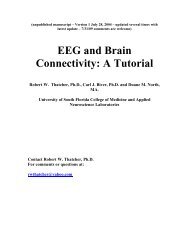Pendant EEG Manual - Bio-Medical Instruments, Inc.
Pendant EEG Manual - Bio-Medical Instruments, Inc.
Pendant EEG Manual - Bio-Medical Instruments, Inc.
You also want an ePaper? Increase the reach of your titles
YUMPU automatically turns print PDFs into web optimized ePapers that Google loves.
<strong>Pendant</strong>® Pod User <strong>Manual</strong> Rel 3.6<br />
Pocket Neurobics<br />
Wireless channel change<br />
It may be required to change the wireless channel number for one of two reasons:<br />
• there is interference from sources such as wireless LANs, or Bluetooth devices<br />
• there is more than one <strong>Pendant</strong>® device within a range of 10 metres<br />
Both the <strong>Pendant</strong>® and the Wireless Dongle need to be set to the same wireless channel. The Wireless Dongle uses the<br />
following mechanism to manually change the wireless channel:<br />
In Programming Mode, activating the V+ or V‐ pushbutton will select one of the eight available wireless channels.<br />
Pressing V+ will increment the wireless channel number by one and pressing V‐ will decrement the channel number by<br />
one. The LED will flash according to the wireless channel selected (a single flash for rf ch1, etc).<br />
Whilst the Wireless Dongle is receiving a valid signal from a <strong>Pendant</strong>® Pod, the green LED on the Dongle will be steady<br />
on, and the wireless channel number will flash off. When the Dongle is not receiving a signal, the LED will be steady off,<br />
and the wireless channel number will flash on. Similarly, when the <strong>Pendant</strong>® is in Operating mode, it’s LED will be steady<br />
on, indicating that it is transmitting, and will flash off the wireless channel number, whereas in Programming mode, it’s<br />
LED will be off and the wireless channel number will flash on. Note that the <strong>Bio</strong>feedback Application software may allow<br />
the user to change the RF Channel number of the Wireless dongle.<br />
Firmware version and serial number<br />
To identify the version of the firmware on your unit, the <strong>Bio</strong>feedback Application may have a tool specific to the<br />
<strong>Pendant</strong>® Pod labelled “About”. The <strong>Pendant</strong>® needs to be in Programming mode to activate this function. The serial<br />
number and version of the firmware of the Wireless Dongle and other devices that the dongle may have “discovered”,<br />
such as a Pod, are reported to the <strong>Bio</strong>feedback Application. Version numbers appear similar to:<br />
• “Dgl20x” – wireless dongle version 20x<br />
• “e0‐20x” ‐ <strong>Pendant</strong>® <strong>EEG</strong> version 20x<br />
• “h1‐20x” – <strong>Pendant</strong>® HEG pIR version 20x<br />
The About function will also identify a serial number such as:<br />
• “sn12345678”<br />
Calibrating the <strong>Pendant</strong> pIR<br />
Pressing the Mode button again changes the mode from Programming Mode (red LED) to Calibration Mode (yellow<br />
LED). In Calibration mode the wireless channel change buttons described above can be used to increment or decrement<br />
the nominal temperature readout +‐5degC at body temperature. This is generally a one‐time operation since the<br />
<strong>Pendant</strong> will remember the last setting. There are 16 increments between ‐5deg and +5deg meaning accuracy of +‐<br />
0.6degC can be achieved. The nominal value (ie no calibration) can be restored by observing the oscilloscope trace<br />
whilst pressing the calibration buttons and counting eight steps from either the maximum or minimum excursion.<br />
Signal Validity<br />
The <strong>Pendant</strong>® Pods transmit information to the <strong>Bio</strong>feedback Application regarding the validity of the raw biofeedback<br />
data. This information will typically appear in the Status Bar of the <strong>Bio</strong>feedback Application:<br />
• <strong>Pendant</strong>® <strong>EEG</strong>: the magnitude of the <strong>EEG</strong> signal. Where the <strong>EEG</strong> signal is excessive, perhaps due to a<br />
poorly contacting electrode, the signal will be flagged as invalid.<br />
• <strong>Pendant</strong>® HEG pIR: thermocouple sensor not connected.<br />
8 © 2008 Pocket Neurobics
















